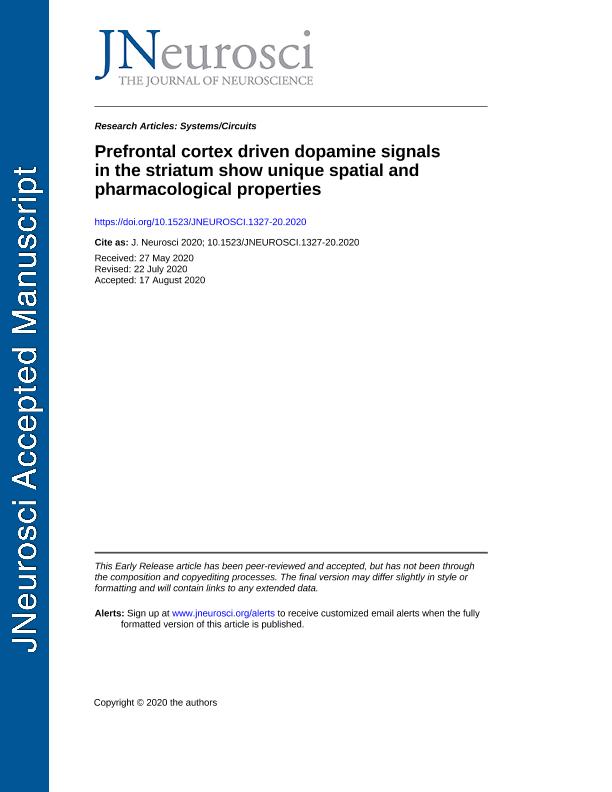Mostrar el registro sencillo del ítem
dc.contributor.author
Adrover, Martín Federico

dc.contributor.author
Shin, Jung Hoon
dc.contributor.author
Quiroz, Cesar
dc.contributor.author
Ferré, Sergi
dc.contributor.author
Lemos, Julia C.
dc.contributor.author
Alvarez, Veronica A.
dc.date.available
2021-03-10T15:03:36Z
dc.date.issued
2020-09-28
dc.identifier.citation
Adrover, Martín Federico; Shin, Jung Hoon; Quiroz, Cesar; Ferré, Sergi; Lemos, Julia C.; et al.; Prefrontal cortex-driven dopamine signals in the striatum show unique spatial and pharmacological properties; Society for Neuroscience; Journal of Neuroscience; 40; 39; 28-9-2020; 7510-7522
dc.identifier.issn
0270-6474
dc.identifier.uri
http://hdl.handle.net/11336/127957
dc.description.abstract
Dopamine (DA) signals in the striatum are critical for a variety of vital processes, including motivation, motor learning, and reinforcement learning. Striatal DA signals can be evoked by direct activation of inputs from midbrain DA neurons (DANs) as well as cortical and thalamic inputs to the striatum. In this study, we show that in vivo optogenetic stimulation of prelimbic (PrL) and infralimbic (IL) cortical afferents to the striatum triggers an increase in extracellular DA concentration, which coincides with elevation of striatal acetylcholine (ACh) levels. This increase is blocked by a nicotinic ACh receptor (nAChR) antagonist. Using single or dual optogenetic stimulation in brain slices from male and female mice, we compared the properties of these PrL/IL-evoked DA signals with those evoked by stimulation from midbrain DAN axonal projections. PrL/IL-evoked DA signals are undistinguishable from DAN evoked DA signals in their amplitudes and electrochemical properties. However, PrL/IL-evoked DA signals are spatially restricted and preferentially recorded in the dorsomedial striatum. PrL/IL-evoked DA signals also differ in their pharmacological properties, requiring activation of glutamate and nicotinic ACh receptors. Thus, both in vivo and in vitro results indicate that cortical evoked DA signals rely on recruitment of cholinergic interneurons, which renders DA signals less able to summate during trains of stimulation and more sensitive to both cholinergic drugs and temperature. In conclusion, cortical and midbrain inputs to the striatum evoke DA signals with unique spatial and pharmacological properties that likely shape their functional roles and behavioral relevance.
dc.format
application/pdf
dc.language.iso
eng
dc.publisher
Society for Neuroscience

dc.rights
info:eu-repo/semantics/embargoedAccess
dc.rights.uri
https://creativecommons.org/licenses/by-nc-sa/2.5/ar/
dc.subject
DA RELEASE
dc.subject
DORSOMEDIAL STRIATUM
dc.subject
FAST-SCAN CYCLIC VOLTAMMETRY
dc.subject
OPTOGENETICS
dc.subject
PFC
dc.subject.classification
Neurociencias

dc.subject.classification
Medicina Básica

dc.subject.classification
CIENCIAS MÉDICAS Y DE LA SALUD

dc.title
Prefrontal cortex-driven dopamine signals in the striatum show unique spatial and pharmacological properties
dc.type
info:eu-repo/semantics/article
dc.type
info:ar-repo/semantics/artículo
dc.type
info:eu-repo/semantics/publishedVersion
dc.date.updated
2020-12-22T15:43:26Z
dc.identifier.eissn
1529-2401
dc.journal.volume
40
dc.journal.number
39
dc.journal.pagination
7510-7522
dc.journal.pais
Estados Unidos

dc.description.fil
Fil: Adrover, Martín Federico. Consejo Nacional de Investigaciones Científicas y Técnicas. Instituto de Investigaciones en Ingeniería Genética y Biología Molecular "Dr. Héctor N. Torres"; Argentina. National Institutes of Health; Estados Unidos
dc.description.fil
Fil: Shin, Jung Hoon. National Institutes of Health; Estados Unidos
dc.description.fil
Fil: Quiroz, Cesar. National Institutes of Health; Estados Unidos
dc.description.fil
Fil: Ferré, Sergi. National Institutes of Health; Estados Unidos
dc.description.fil
Fil: Lemos, Julia C.. National Institutes of Health; Estados Unidos
dc.description.fil
Fil: Alvarez, Veronica A.. National Institutes of Health; Estados Unidos
dc.journal.title
Journal of Neuroscience

dc.rights.embargoDate
2021-04-23
dc.relation.alternativeid
info:eu-repo/semantics/altIdentifier/url/https://www.jneurosci.org/content/40/39/7510.long
dc.relation.alternativeid
info:eu-repo/semantics/altIdentifier/doi/http://dx.doi.org/10.1523/JNEUROSCI.1327-20.2020
Archivos asociados
